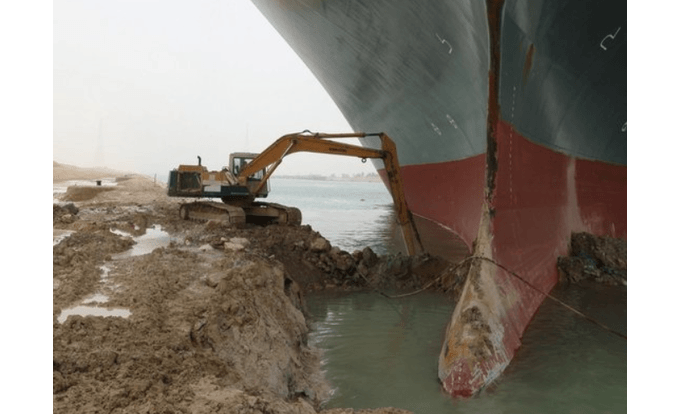Rapid build-up of tankers and laden vessels at blocked Suez Canal as alternatives are limited

Overnight on Tuesday, the container Ship Ever Given ran aground in the southern part of the Suez Canal, a rare event in the history of the waterway.
The potential for a rapid build-up of liquid and gas tankers in the region is marked with multiple laden vessels now indicating major delays for their Suez transit.
As of this morning there were seven vessels carrying crude, 15 carrying refined products, five LNG vessels and two LPG carriers either sat waiting or approaching the canal, according to data released by commodities intelligence platform Kpler this afternoon.
“While attempts to clear the ship from the canal continue, this queue will continue to build. A salvage squad from the Netherlands will attempt to dislodge the ship beginning Thursday,” Kpler analysts said in a note shared with City A.M.
Liquified natural gas market
The LNG market faced constraints around the Panama Canal through winter amidst a spike in East Asian demand and cargo re-routes were necessary. However, the analysts pointed out “there is distinctly less optionality for shippers this time around.”
“The LNG market has already had a taste this winter of what can happen when logistical pinch points are tested to the maximum. East Asia pulled significant quantities of last minute cargoes into the region, straining the limits of the Panama Canal and forcing shippers to seek alternative routes.”
The options for shippers in the immediate aftermath of the incident in the Suez Canal are far more limited.
As delays continue, shippers will have to broach the unpalatable decision of whether to make a u-turn and head for the Cape of Good Hope or wait it out in the Red Sea and Mediterranean, Kpler said.
Given the considerable increase in voyage duration, it is unlikely that anyone already in-situ will divert, as Suez to Amsterdam at 12 knots is just over 13 days via the canal or 41 days via the Cape.
“This could cause shippers not already committed to reassess their options, but there would still need to be notice of longer running delays before those decisions were made, it takes just under 24 days via the canal from Ras Tanura to Amsterdam vs 39 days via the Cape.”
Fragility of the Suez Canal
The event highlights the relative fragility of the on-water trading system, particularly for those flows for which Suez Canal transits make up a higher percentage of total volumes moved.
Daily traffic of all liquids tankers through the canal, both laden and ballast and north as well as southbound, ranges between lows averaging eight per day in January 2018, up to a high of 15.3 per day in May 2020, according to Kpler.
Since a recent low of 9.7 transits per day in July 2020, the number of tankers moving though the Suez had increased steadily, reaching 12.3 per day up to yesterday, before the blockage of the canal.
Over the last couple of years, 80 per cent of these transits have been for laden vessels, according to the Kpler data.
“Considering the current level of liquids tankers and LNG carriers transiting the canal compared to previous highs, there is scope to increase movements once the canal has been cleared,” the analysts wrote.
“At that point the pressure from the rest of the shipping fleet to clear the backlog will need to be taken into account.”